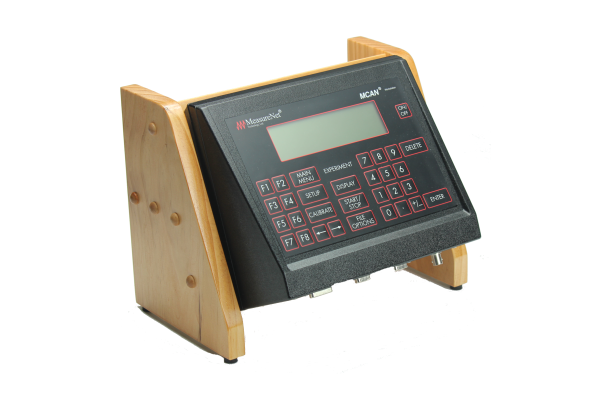
The modernization of a universities General Chemistry laboratory program can be a daunting and yet necessary task. This is especially true when you have 2000+ students taking General Chemistry every year. The University of Tennessee, Knoxville decided it was time to modernize their General Chemistry Lab Program for them to remain competitive. They knew that Electronic Data Collection Technology needed part of this process, and needed to be integrated into the labs. I am happy to say The University of Tennessee, Knoxville decided MeasureNet's Electronic Data Collection System was the technology selected in the redesign of their General Chemistry Laboratory Program.
“The laboratory makeover not only benefits the first-year students, but will help improve their preparation and success as they go on to take upper-level chemistry courses, “
Al Hazari, Director of Undergraduate Laboratories.
MeasureNet has added some new features to our LabKonnect™ data storage site and PC software that provide you and your students with even greater flexibility than before.
- Automatic Data Files Graphing
- Online Lab Report Storage/Submission
- Extended Experiments with Remote Monitoring
Automatic Data Files Graphing
With the rollout of the new LabKonnect features, we decided to make it easier to get a quick idea of your data sets. Users can graph any data set uploaded through the MeasureNet Lab PC software right on the LabKonnect™ site.

Online Lab Report Storage/Submission
MeasureNet LabKonnect now allows students to upload their lab reports and store them on the cloud. Instructors can download the lab reports, grade them, and then upload the graded lab report to the student's account for instant feedback with no wasted paper.
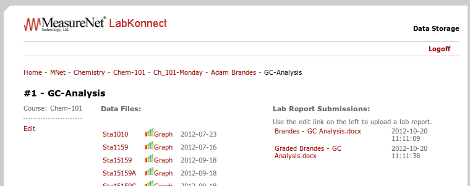
(Lab Report View)
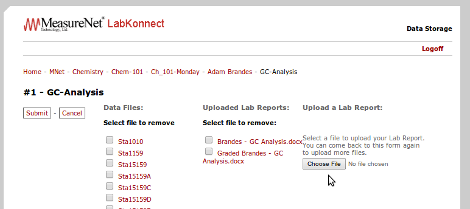
(Lab Report Upload)
Extended Experiments with Remote Monitoring
One of MeasureNet's most exciting new features is the ability to conduct extended length experiments and remotely monitor them from the web. If you have an experiment with a slow reaction that needs to be monitored over several days, you can go home and have fun while still collecting your data. MeasureNet will even send you a text message if your experiment goes out of bounds. That way you can come in and fix your setup without losing days worth of valuable data.
You can set up your alert conditions online, and then start the extended experiment with the Lab PC Software. After that, you just let your experiment run until you choose to stop it.
This capability is ideal for research projects that require the monitoring of experiments that run for days or weeks. The William Heineman research group at the University of Cincinnati has been using this feature for a number of their research projects.
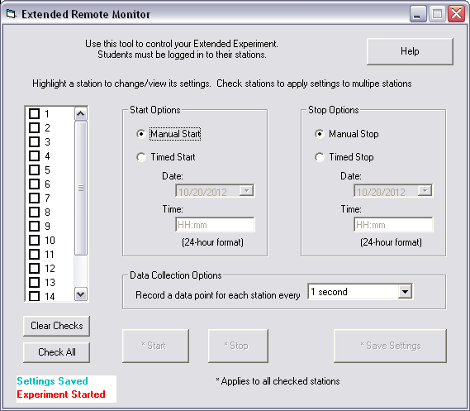
(Setting Up Extended Experiment in Lab PC Software)
If you want to check up on your data and see how it's trending, you can log in and graph or download the data that has been collected so far. You can also leave comments on each of the extended experiment files in case you want to do multiple runs.

(View and Graph Extended Experiment Files)
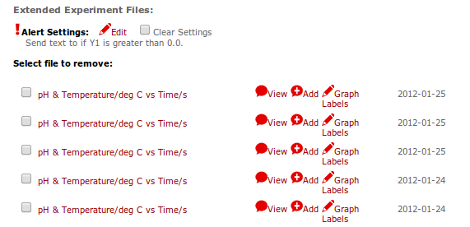
(Mange Extended Experiment Files)
The folks here at MeasureNet have been hard at work integrating new probes into our system and creating new experiments. In this blog entry we'll be introducing the following new experiments and probes:
- Thermometric Titrations
- Conductivity Probe & Experiment Options
- Colorimetric Titration Hardware
Thermometric Titrations
The newest software integrates the drop counter and temperature probe and now has the capability to conduct experiments with Temperature vs Drops. This allows users to conduct Thermometric Titrations.
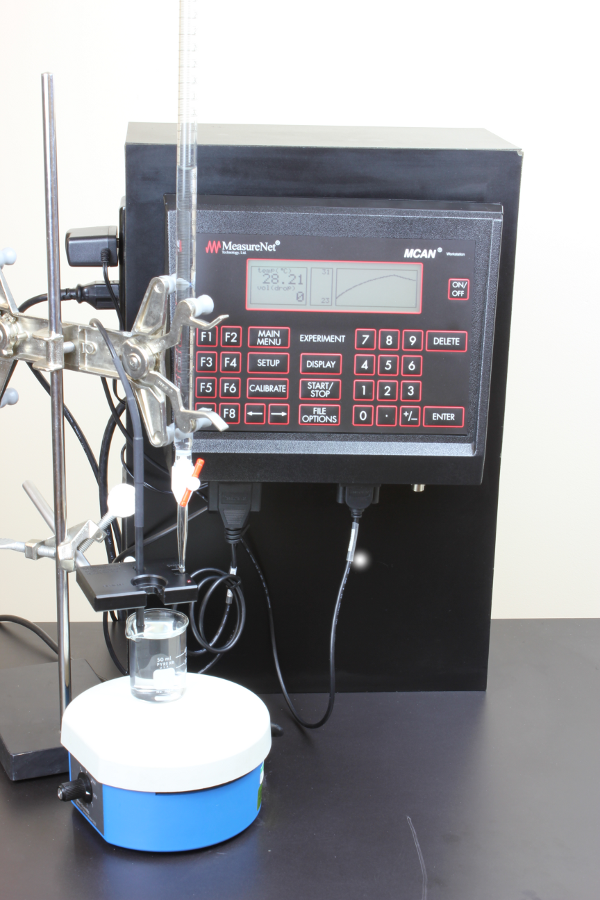
Conductivity Probe & Experiment Options
MeasureNet now offers a 4 range high resolution conductivity probe. MeasureNet provides users the ability to conduct experiments with Conductivity vs Time and use the drop counter for Conductivity vs Volume for Conductometric Titrations.
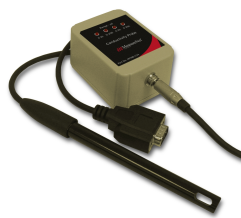
Colorimetric Titration Hardware
MeasureNet systems now have the ability to conduct colorimetric, Fluorometric, turbidometric and chemiluminescent titration experiments. When ordering colorimeters, customers can specify if they would like them customized for photometric titrations. The kit includes a colorimeter, a base stand, a pump with power supply, and custom-made flow cell that pair with the MeasureNet colorimeter and drop counter.
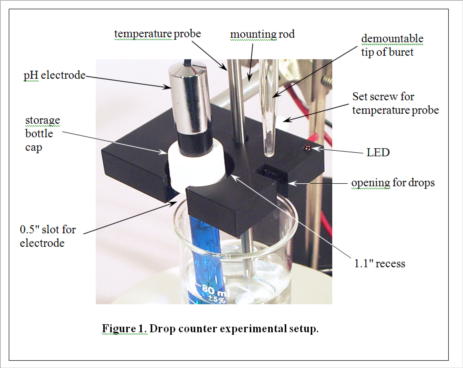
Development of MeasureNet’s optical drop counter began in 2000. Our goal was not only to automate, simplify and shorten the time for pH titration experiments, but also to improve the accuracy of students’ measurements. During its development, various innovative features were added to the design, as seen in Figure 1. MeasureNet’s Multi-Functional Drop Counter holds both a pH probe and a temperature probe, reducing the hardware needed to set up pH titration experiments, and the geometry was optimized to allow the use of small beakers and samples.
Before the days of optical drop counters, simple wire electrical conductivity devices were the only automated and economical solutions for pH titrations in the teaching laboratory. A drop from the buret would make contact with two bare wires positioned closely together, creating a conductive current path. An electronic circuit would then convert this current into a pulse that was counted. A student could then calculate volume based on the number of drops and the average drop size, determined in a separate experiment. The MeasureNet system automatically determines the average drop size in each titration.
The most common method of performing pH titrations is the manual method. The drawbacks to this method:
Time consuming, giving students time to perform few titrations in a lab period.
-
Larger reagent volumes required, making titrations more expensive in terms of reagent usage and disposal.
-
Requires repetition for students to master endpoint detection with reasonable precision.
The 22nd BCCE at Penn State University marks the 10th anniversary of MeasureNet Technology’s introduction of the Optical Drop Counter to the chemical education community. During this decade, the MeasureNet drop counter has become a star in chemistry labs around the country and the world, performing a variety of functions even its designers had never imagined. MeasureNet’s drop counter allows students to leap past the typical pH titration experiment and engage in other interesting and educational titration methods like thermometric, potentiometric, amperometric and colorimetric titrations.
MeasureNet Technology's introduction of the industry’s first Multi-Functional Optical Drop Counter technology in 2002 at the 17th BCCE at Western Washington University obviously caught the attention of the conference attendees and venders. The MeasureNet drop counter has emerged as the industry standard, copied by all its competitors, such as Vernier Software & Technology, Pasco Scientific and MicroLab Inc. MeasureNet is both flattered by this attention and inspired to do more to bring innovative technology into the teaching laboratory.

American students are falling into a giant chasm between the classroom and the workplace.
For three days in 2012, some of the biggest and brightest stars of business and education gathered in Dallas to explore the gap between the types of technical jobs that modern industry has to offer and the ability of workers to perform those tasks. As it stands now, workers simply do not have the advanced skills that employers need. High paying job positions go unfilled, leaving empty holes where a worker should be.
The STEM Solutions 2012 Summit tried to fill in the holes and build pathways that allow students to move more freely from the classroom to the STEM-rich workplace. During the summit, NMSI President & CEO Dr. Mary Ann Rankin encouraged listeners to accelerate STEM education in a panel discussion entitled, “The Supply Side: Education and America’s STEM Future.” The panel looked at various ways to produce enough STEM graduates to satisfy corporate hunger.
Summit participants agreed it is especially important to fill those positions with women.
STEMConnector’s new publication, 100 Women Leaders in STEM, featured Dr. Rankin. Women make up 48 percent of the workforce, yet hold only 24 percent of U.S. STEM jobs. Fewer than 15 percent of American engineers are female.
In another panel discussion, Dr. Rankin focused on defining, understanding and closing the gap between the skills needed by corporations and those offered by today’s universities.
This gap begins as small crevices in early education. Student brains stagnate through boring lectures and memorize facts instead of participating in hands-on education, known to excite young minds about science, technology, engineering and math, or STEM. This stagnation shows in dismal STEM scores. Barely 18 percent of high school seniors perform at proficient levels in science courses.
Weak STEM skills results in poor job prospects and low pay. A student without a solid understanding of STEM subjects cannot develop the technical skills necessary to participate in today’s job market. Employees with poor technical skills will ultimately fail in the modern, highly technical workplace.
Summit participants identified gaps between institutions, with each school adhering to slightly different standards and teaching methods. For example, a kid from one elementary school uses microscopes in the classroom while a child who attends school across town does not. These students eventually merge into a high school science class; the gap between the student with hands-on experience and the one without becomes clear quickly. This gap grows each time the students move from one institution to another, from elementary school to graduate school.
The summit called on educational institutions to fill in the gaps between elementary school, high school, college and graduate school. Many students fall into these gaps and away from careers in STEM fields. Improve each educational segment’s shared understanding of what is necessary to be “college-ready.”
MeasureNet is a prime example of educational technology that actually closes the gap between students and high paying jobs. MeasureNet puts real-world tools into the hands of students of all ages. Instead of sleeping through boring lectures, students use the same inquiry-based chemistry labs, environmental chemistry, instrumental methods, STEM and biochemistry procedures as professional scientists. MeasureNet helps students leap across the STEM chasm and land onto a great-paying job.

According to the American Chemical Society, hands-on activities significantly enhance learning at all levels of science education. The American Chemical Society, or ACS, is the world’s largest association of individual chemical scientists and engineers, and its newest science education policies communicate the importance of hands-on learning in the science lab. ACS education programs begin pre-kindergarten and extend through undergraduate and graduate studies.
Hands-on activities are the basis for the laboratory portion of any science class and are essential for learning chemistry. A student enrolled in a hands-on chemistry course directly experiences laboratory chemicals, chemical properties and reactions as well as gaining familiarity with laboratory equipment and apparatus. There is simply no substitute for the real-life experience of hands-on training.
One good example demonstrating the superiority of hands-on learning over simulation or lecture is teaching a child to ride a bicycle. Putting a child on a bike and giving her a push teaches her much more in one minute than she could gain by watching videos of other children on bicycles or listening to a lecture on physics. Hands-on learning allows for deeper comprehension of scientific principles, and it benefits the American Chemical Society and the rest of the United States to campaign for a return to this inclusive style of education.
ACS has good reason to promote hands-on learning. A 1982 meta-analysis of 15 years of research including 57 studies of 13,000 students showed that students who participated in hands-on education scored 20 percent better than did students using traditional or textbook approaches. The students engaged in hands-on learning demonstrated gains in creativity, attitude, perception and logic. The National Assessment of Educational Progress noted that teachers who incorporated hands-on activities into the curriculum at least once a week out-performed their peers by more than 40 percent of a grade level in science.
No Child Left Behind act, or NCLB, appears to have had an unintended negative impact on hands-on learning, particularly for children at the elementary and middle school ages. Science is not a federally mandated assessment, so teachers and administrators instead focused on subjects compliant with NCLB assessments such as reading and math. Pupils who were students during the height of NCLB continue to struggle with this deficit well into their post-secondary education unless given an opportunity to catch up with adequate hands-on training in the laboratory. For many, this chance does not occur until high school or beyond, if at all.
Undergraduate and graduate institutions must offer hands-on opportunities in the laboratory to ensure graduates are able to meet and overcome the challenges of modern chemistry. Some of these advanced students will rely on these skills to solve real-world problems in the workplace while others return to the classroom to teach others. ACS challenges teachers to reach new goals of excellence and advocates certain measures to help educators achieve superiority, including requiring teachers to take undergraduate courses to ensure they are prepared to teach coursework and enhancing funding at all levels so that science teachers have access programs that allow them to expand and update their science knowledge base. ACS also encourages teachers and school systems to use technology to reach students with different learning styles. The ACS is also dedicated to improving the work conditions of science teachers, reduce attrition and improve safety in the classroom laboratory.
Some educators are tempted to take advantage of the shortcuts modern technology has to offer but teachers should choose wisely. Computer simulations are flashy and inexpensive but are not an adequate substitution for hands-on activities, even at the collegiate level. Educators must use computer simulation as a supplement to, not as a replacement for, hands-on learning. While intellectual curiosity should be piqued with internet searches, guided by lectures and accelerated with computer simulation and video, hands-on learning is still one of the most effective ways to instill confidence in knowledge and increased comfort with using laboratory and technical equipment.
ACS recognizes the special need for new assessment equipment at the undergraduate level. This equipment should assess a student’s understanding of science and the use of methods of science to give the instructor a fuller appreciation of the student’s grasp of science, not just his ability to recite scientific facts. Giving students access to a shared diode-array visible or UV-vis spectrometer to perform absorption, emission, fluorescence and reflectance experiments has so much more impact than just describing.
The American Chemical Society emphasizes the importance of a hands-on, inquiry-based approach to science to not only help students gain knowledge and understanding of scientific principles but also to teach students how scientists explore and make sense of the natural world. Hands-on learning teaches students to learn with the same tools used by professional scientists. It teaches them to think like scientists by creating hypotheses, making observations and performing inquiries. Students improve skill proficiency in scientific processes, such as laboratory work, graphing results and interpreting data.
Hands-on learning has been around since the days of Aristotle, who said, “What we have to learn to do, we learn by doing.” Hands-on learning enhances the student’s ability to test, sense, apply and learn. This type of learning involves and improves upon the art of questioning. Use hands-on, state of the art analytical instrumentation to revolutionize the way your students learn chemistry and science in your classroom laboratory.
“I hear and I forget, I see and I remember. I do and I understand”
Chinese proverb

“Why do I have to learn junk I’ll never use in real life?” is arguably the most harrowing question to ever echo in a science or math classroom. For generations, an education in science, engineering or math has been mostly reserved for only those very bright students intending to pursue an advanced degree in one of those disciplines. Most of these students were white males, with strong social stigmas preventing females or students in minority groups from participating. Students who wanted to work in other professions or stay at home to raise kids often avoided science and math classes, thinking a working knowledge of these subjects unnecessary for a workaday life. Today’s fierce global economic climate does not allow modern student to cherry-pick skills to take into the workplace – even the most rudimentary jobs require a certain amount of technical sophistication and understanding of STEM subjects. While most students will not eventually work in a STEM field, they will enjoy life-long benefits from their experiences studying in a STEM-rich environment.
National Economy
A workforce well-educated in science, technology, engineering and math, or STEM, skills is now an absolute necessity to keep the United States in a competitive position in today’s global economy. According to a 2009 assessment of 15-year olds, the United States pulled a below-average ranking of 32nd in mathematics and an average rank of 23rd in science. These dismal statistics worry economists, industry leaders and politicians who recognize the power innovations science and technology has on the nation’s positions in the global markets. Knowledge is the engine that drives that innovation. Our nation needs an innovative strategy to its technical strength enough to compete in today’s global economy.
Improved Learning
One of the most obvious and innovative national strategies is to put STEM technology directly into the hands of high school students. STEM education transforms a teacher-centric classroom into a laboratory where curiosity and innovation propel discovery and learning. Cutting-edge STEM education tools replace dusty static textbooks with real-life technology. Lectures and memorization are swapped with curiosity and discovery, a more natural and long-lasting form of learning. The faces of students in an interactive STEM laboratory setting brighten as natural curiosity and inquisitiveness reawaken and reinvigorate their imaginations. The student shakes off her role as a passive learner and jumps right into the business of innovative thinking and learning. This type of exploratory thinking encourages valuable problem-solving and discovery skills students can use later in life, whether they plan to further their STEM education, go directly into the workforce or even stay at home and raise children.
Critical Thinking
Classes in STEM studies enhance critical thinking skills and require students to actively engage in a situation in order to find the solution. Students develop the same problem-solving skills in the secondary and post-secondary classroom as they will eventually use in the workplace. A savvy educator puts current technology into these students’ hands so they grow comfortable using these tools. Youngsters build STEM-specific proficiency along with critical thinking skills and familiarity with equipment as they go through secondary and post-secondary school or directly into the job market.
Increase Interest in STEM
Education in STEM studies during high school promotes interest in pursuing a post-secondary STEM degree. In a recent survey, four out of five STEM college students say they decided to study STEM while still in high school; more than half say that a specific class or a teacher, rather than a family member, got them interested in STEM subjects. This is especially true for women, with 68 percent of female students citing a teacher or a class as being the main motivation behind their decision to study STEM. Unfortunately, only one in five college STEM students say that elementary and high school adequately prepared them for college STEM courses. These students said it would have been helpful to take more STEM courses and for these courses to be more challenging.
Improved Collegiate Performance
The universities teaching advanced STEM courses would agree. One of the largest problems post-secondary institutions face is under-prepared freshmen. Universities and colleges yearn for entrants who are better educated in STEM subjects. Students entering STEM studies are woefully underprepared for collegiate courses and many students drop out before earning a degree.
Better Pay
Post-secondary STEM education results in better pay, even for workers who wind up in non-STEM positions. A person with a STEM degree will earn 13 percent more for the same job as another person without such credentials. This is especially true for women and minorities in STEM fields. While there is a gender and race gap associated with most other professions, women in STEM jobs make almost as much as their male counterparts.
The STEM skills learned in high school will serve a student well, even if she does not pursue a college degree or work in a STEM field. Even jobs in a big box store or fast food chain requires the use of hand-held electronic devices or scanners. Only repetitive, manual labor tasks do not require at least a fundamental education and the need for workers to perform this type of work has declined rapidly since the 1960s. Technology and robotics have replaced these workers with industrial machines. Today’s employers require interactive workers able to perform non-routine tasks based on a sound decision-making.
A secondary education rich in STEM studies benefits all students, whether they intend to pursue an advanced degree in the sciences or just work at the local discount store. STEM studies help students develop critical thinking skills, familiarize future workers with the equipment they will someday use and spark an interest in STEM fields. Improving secondary STEM education will improve our national workforce and enhance the way American workers do business.Discover all the learning solutions you can incorporate into your STEM laboratory.
Sparking a student’s interest in science, technology, engineering or math can launch her on a new career in the highly-lucrative and rapidly-expanding opportunities in STEM fields. Great pay, interesting work, job security and good working conditions are the norm for those holding a STEM degree or working in a STEM field, such as computer and information technology, engineering or life science. STEM fields are closing the gender gap, encouraging more women to reap the benefits of an education in science and technology. Solid STEM training benefits the workers of today and tomorrow.
Good Pay
Whether you earned a degree in a STEM field or you work in a STEM field without holding a diploma, STEM increases your average wages. A STEM worker with a bachelor’s degree will earn on average $7 more per hour than another person with the same credentials in a non-STEM occupation. Just holding a degree in a STEM field will increase wages. A person with a STEM degree makes 13 percent more doing the same job as a person without such an education. Those who study STEM or gain a degree in a STEM field have higher wages, even if they don’t ultimately work in a STEM field.
To put it in hard numbers, the Bureau of Labor Statistics, or BLS, reports the average annual wage for all STEM occupations was $77,880 in May of 2009. Natural science managers were the highest paid STEM workers, followed by engineering and computer science managers. These highest-paid workers held mean wages in excess of $100,000 or more.
Interesting Work
Working in a STEM job is exciting. All the cool things we love today are the result of the innovating and creative thinking of countless STEM workers, including our phones, computers and video games, live-saving medicines and other technical miracles. Whether a STEM worker uses her skills to bring a rare species of animal back from the brink of extinction or to design the automobile of tomorrow, work in a STEM field will always be challenging and highly rewarding.
Lower Unemployment
Workers in STEM jobs face a lower risk for unemployment than laborers in other fields. In 2010, unemployment rates among non-STEM workers were almost 10 percent, compared to only 5.3 percent unemployment among STEM workers. It is possible that this lower unemployment rate is due to the higher level of education among STEM workers; solid education, especially in STEM fields, reduces unemployment.
Increased Opportunities
The topic of STEM jobs and the education to get those lucrative jobs has never been hotter. The BLS projects STEM job growth to have grown 22 percent between the years of 2004 and 2014. Computer specialist occupations are expected to have grown much faster than average. Despite a sluggish national and global economy, STEM jobs continue to enjoy expanding opportunities for well-educated workers.
Decreased Gender Gap
There is a smaller economic gender gap in STEM jobs than in other professions, with women earning nearly the same income as men for performing a STEM job. Women who work in STEM fields make on average 33 percent more than women who work in non-STEM jobs. Many women with a STEM degree work in education or healthcare rather than in a STEM field.
Good Working Conditions
STEM jobs are usually performed inside air-conditioned offices or laboratories in technical parks located in nice sections of the country, such as southern California or Boulder, Colorado. Most of these jobs are quite safe, extremely exciting and always challenging. STEM workers typically share clean, quiet environments with other well-educated, like-minded professionals.
Before a worker enters the profitable and rewarding STEM field, he needs a solid STEM education. Early and secondary education is the key, whether a student plans to study STEM or enter a STEM field directly out of high school. Introducing students to science, technology, engineering and math at an early age can foster a passion that puts future workers on the right path, rich in financial and professional rewards.
http://educationupdate.com/archives/2011/NOV/HTML/col-stemjobs.html
http://www.bls.gov/opub/ooq/2007/spring/art04.pdf
http://www.bls.gov/opub/mlr/2011/05/art1full.pdf
http://www.esa.doc.gov/sites/default/files/reports/documents/womeninstemagaptoinnovation8311.pdf

President Barack Obama hosts the second White House Science Fair celebrating the student winners of a broad range of science, technology, engineering and math (STEM) competitions from across the country. The President talked with Samantha Garvey, 18, of Bay Shore, N.Y., about her environmental sciences project examining the effect of physical environment and predators on a specific species of mussel, in the State Dining Room of the White House, Feb. 7, 2012. (Official White House Photo by Pete Souza)
Administration and Private Sector Announce over $100 Million in Commitments and Additional Steps to Prepare 100,000 New Science, Technology, Engineering and Math Teachers
Shots were fired in the State Dining Room on February 7, 2012, much to the delight of President Obama and the school children attending the second White House Science Fair. Joe Hudy grabbed hold of his Extreme Marshmallow Cannon and blasted a pair of curtains with extreme prejudice after allowing the president to pump up the air-powered canon. The President added power to the science project before placing the technology back into 14-year-old Arizona student’s hands. During the science fair, President Obama announced new steps aimed at putting today’s powerful technology directly into the hands of students in hopes of helping young people do better in science, technology, engineering and math, collectively known as STEM.
President Obama has issued a national challenge to prepare 100,000 qualified STEM teachers within the next decade. These teachers will then, in turn, help one million students graduate with degrees in STEM fields within the next ten years.
The first step to achieving these goals included a request for $80 million for teacher preparation in the fiscal 2013 budget, sent to Congress on February 13th, 2012. This money will support effective STEM teacher training programs, such as those that allow a student to earn a teaching certificate along with a degree. Another $22 million comes from pledges by philanthropic and private sector organizations. More than 115 organizations immediately responded to President Obama’s call to action by creating a group called “100Kin10.” Fourteen of these organizations, including the Carnegie Corporation, Google and Bill & Melinda Gates Foundation, announced a $22 million fund intended to prepare and support STEM education. The future of these organizations rely on a highly educated workforce and are dedicated to improving the skills of future workers by putting state-of-the-art technology directly into the young hands of aspiring scientists.
The 100Kin10 partners have also made more than 100 individual commitments, including Race to the Top competition. President Obama believes that improving STEM education relies heavily on systemic reform on the state and local level and that these reforms should expand opportunities for hands-on learning. The Department of Education will focus on STEM criteria during the Race to the Top competition as a way to improve students’ achievements and interest in STEM studies.
It is imperative that educators put current technology into the hands of students. Students have a natural curiosity about cutting-edge technology but sometimes lose interest because the student does not connect exciting STEM careers with the boring, outdated equipment he uses in his school laboratory. Educators have the unenviable task of making this connection for the student. Products such as the Measurenet MCAN Laboratory Electronic Data Collection system makes this job easier by ensuring students are using the same technologies in the school laboratory as used in postsecondary and professional applications.
Industry leaders agree that a hands-on approach in secondary and postsecondary education will improve the standing of American companies engaged in global economic competition. Practical experience with technology and instrumentation is a valuable asset, both to students planning to go to college and to those entering the workforce directly from high school.
The White House and its partners are aiming higher when it comes to preparing students for future jobs in science, technology, engineering and math. The administration and the private sector are firing back against competitors in the global market by arming highly qualified instructors with the finest educational supplies and techniques, and by building new pathways between teachers and students. Perhaps the best ammunition for the Extreme Marshmallow Cannon was the teacher who put today’s cutting-edge technology directly into Joe Hudy’s hands.

Carl Sagan once said, “It’s suicidal to create a society that depends on science and technology in which no one knows anything about science and technology.”
The United States is slipping behind other countries in awarding postsecondary STEM degrees. Between 1998 and 2006, the total number of STEM degrees grew by 23 percent in the United States. During this same period, Poland increased its number of STEM degrees by 144 percent and Taiwan boasted a 178 percent increase. China’s number of postsecondary STEM degrees exploded by a stunning 200 percent. In 2006, China awarded nearly double the number of postsecondary STEM degrees gained in the United States. The USA needs more STEM degrees if it hopes to compete in tomorrow’s global economy.
More STEM degrees mean more STEM jobs. Increasing the number of jobs in STEM fields is critical to the economic prosperity of both individuals and communities. Generally speaking, STEM jobs are some of the highest paying positions, with wages significantly above the US average. STEM jobs represent one of the fastest-growing segments of the job market, both in the United States and globally. Between 2008 and 2018, the number of STEM jobs is expected to have grown by 17 percent.
STEM occupations are associated with lower unemployment rates when compared to other professions. Students who graduate with a STEM degree but pursue jobs in non-STEM fields also make more money than those with degrees in other fields. Cities across the nation try to attract STEM professionals because civic leaders understand that the high pay and economic stability associated with STEM jobs benefits the economic and social fabric of the community.
The main pathway to a lucrative career in STEM fields is through postsecondary education. Getting bright minds into postsecondary programs poses a two-fold challenge to secondary educators – sparking interest in pursuing further education in STEM studies and properly preparing students to engage in higher learning. In most K–12 systems today, math and science subjects seem to have little to do with the real world. Students often ask, “When will I ever use this knowledge?” Students just don’t seem interested in STEM and educational institutions fail those few students leaning towards a STEM degree.
The National Governors Association explored this challenge in the December 2011 updated version of Building a Science, Technology, Engineering and Math Education Agenda. This committee examined the goals of the STEM agenda and outlined why this agenda is so important to the states and to the nation. They identified weak links in the system and outlined strategies to implement state-wide STEM agendas in ways that excite students about STEM studies and careers while giving them the tools to succeed in gaining a degree and securing a job.
The STEM agenda has two basic goals: expand the number of students entering postsecondary STEM studies and increase STEM proficiency in the general student population. The first goal improves the technical capabilities of the nation’s workforce while the second goal helps students implement concepts and problem-solving strategies gained through STEM studies into their everyday lives.
Proficiency in STEM facts, principles and techniques are just as beneficial to future employees of big-box stores as they are to the physicians and engineers of tomorrow. Integrating STEM concepts and hands-on learning into the regular curriculum will help the general student population hone critical thinking skills to recognize, evaluate and solve problems not related to science, technology, engineering or mathematics.
This study identified five areas that states are trying to improve upon in an effort to increase the number of interested students qualified to pursue postsecondary STEM studies. Inconsistent state standards, a shortfall of qualified instructors and failure to motivate student interest all prevent students from pursuing postsecondary studies in STEM. This study also suggests that students are not prepared for postsecondary STEM study because they lack hands-on learning and experience with laboratory equipment. Worse yet, many current postsecondary STEM studies do not properly prepare students to work in STEM fields.
Fortunately, the report by the National Governors Association contains solid research that provides direction to increasing the presence of STEM tools in your learning laboratory in a way that propels your students into postsecondary studies and high paying STEM jobs. Building a Science, Technology, Engineering and Math Education Agenda says that several studies correlate strong preparation in high school with improved STEM degree completion rates. Furthermore, certain high school instructional practices seem to be more effective than others, including doing hands-on experiments in science. Encouraging high school students to form workgroups also improves postsecondary STEM outcomes.
Use informal learning to help students make the connection between STEM classes and real-world applications. Field trips to museums, science centers and other public and private institutions showcase job opportunities for those with degrees in STEM fields. Many of these institutions provide hands-on activities using the same equipment professionals employ. The connections between STEM classes and real-world applications are reinforced when your students can then use these same pieces of equipment in their own classroom laboratories.
The National Governors Association notes that a “student’s ability to enter and complete a STEM postsecondary degree or credential is often jeopardized because the pupil did not take sufficiently challenging courses in high school or spend enough time practicing STEM skills in hands-on activities.” Hands-on learning chemistry labs improve a student’s experience in secondary school, giving her confidence to succeed in postsecondary STEM studies or in an entry-level non-STEM career.
Our nation’s security and economic stability rest in the capable hands of exceptional educators just like you. It is up to STEM educators to expand the knowledge of science and technology not only in collegiate hopefuls but in the student population as a whole. Improve your students’ chances of success competing in a global economy by training them the same chemistry laboratory equipment that universities and professionals use.